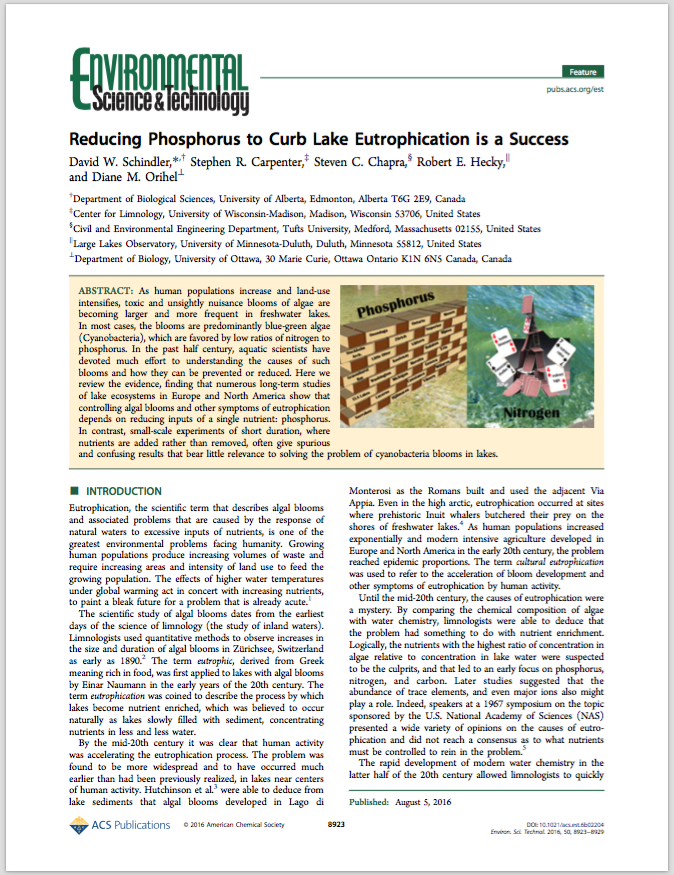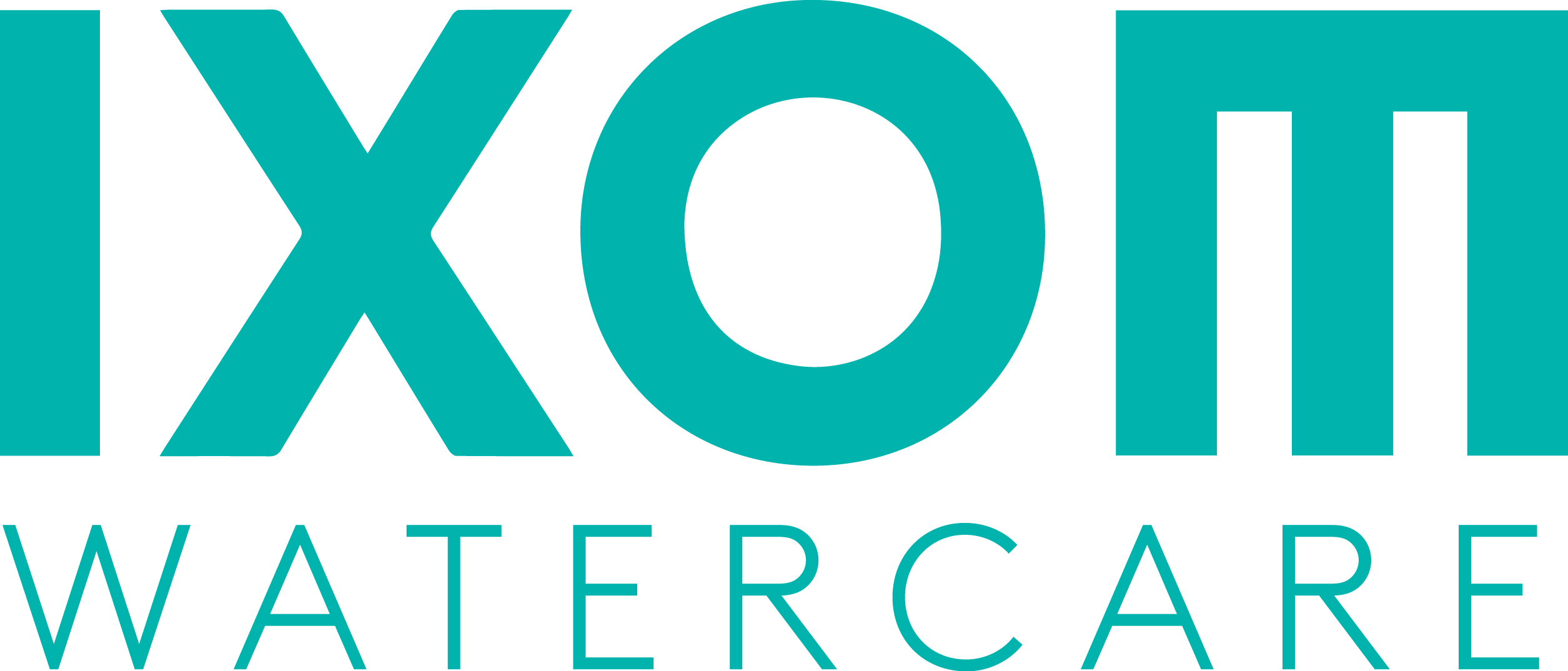Review: The Role Of Phosphorus & Nitrogen In Freshwater Algae Blooms
Is the “settled” extreme pushing the science out of balance?
 In August 2016, Environmental Science & Technology published an article about preventing or reducing harmful algae blooms in freshwater lakes. "Reducing Phosphorus to Curb Lake Eutrophication is a Success” was co-written by several lake scientists from the United States & Canada with D. Schindler (Edmonton, Alberta) as the lead author. (read & download the article here)
In August 2016, Environmental Science & Technology published an article about preventing or reducing harmful algae blooms in freshwater lakes. "Reducing Phosphorus to Curb Lake Eutrophication is a Success” was co-written by several lake scientists from the United States & Canada with D. Schindler (Edmonton, Alberta) as the lead author. (read & download the article here)
The article seems to say that:
1) Phosphorus is the the only nutrient that matters to control cyanobacteria harmful algae bloom (HABs).
2) Any further discussion of nitrogen as a nutrient in this industry is a waste of time.
3) Given enough time (maybe 10-30 years), watershed protection to reduce phosphorus infow to lakes will stop cyanobacteria blooms.
The article lists about 35 lakes in the world as evidence to support the claim that phosphorus reduction can “recover" a lake. There is not much discussion about point sources versus non-point sources in the article; but usually 90% of phosphorus inflow to lake is non-point source, so the clear implication is that watershed protection is the only way to restore a lake.
Schindler has been saying for years that HABs are only about phosphorus; whereas, Hans Paerl (North Carolina, USA) says sometimes HABs are caused by excess phosphorus, and/or excess nitrogen, and/or other factors. This article seemed to be a direct slam to Paerl continuing the rivalry between the two, Schindler and Paerl.
This article is also an indirect attack on the work of our own Dr. Ken Hudnell (Medora Corporation, formerly with the US EPA) and the North American Lake Managers Society (NALMS). Ken worked over 20 years at the US EPA and has kept in contact with various Washington DC and other regional offices. He cannot find any lake of any size in the United States in the past 50 years where watershed protection to stop phosphorus inflow has restored a lake when most of the phosphorus input has been from non-point sources. The reason is that there are too many other phosphorus inputs (from internal loading, groundwater, atmospheric loading) and it takes very little phosphorus to allow HABs to form in the first place.
There Is No One Size Fits All Solution, The Adaptive Systems Approach Provides Cost-Effective Flexibility
For the past 3 years, Ken and NALMS have been promoting to lawmakers an Adaptive Systems Approach (ASA) to lake management. With the ASA, there would be some accountability for funds spent to restore a lake for the first time in over 50 years. It would no longer suffice to spend every single dollar on watershed management when everybody knows the lake will not improve for another 50 years (if ever). Instead, some money should still be spent on watershed management to capture the “low hanging fruit” while some of those same funds are put into “in-lake treatments” as well. With an Adaptive Systems Approach, the taxpayers get a continuously usable lake while the watershed is slowly improved over time. The cost of the restoration will often be only a fraction (5% or 10%) of the cost communities & taxpayers are now spending for costly & regulation heavy watershed protection alone.
The Noted Successes Are Disappointing
The article's lists 35 lakes worldwide where watershed cleanup alone restored the lake, not in-lake treatment or the use of aluminum sulfate (alum) or other chemicals. Of these, 9 were in the US so I had to check them out right away. I hoped to find some clear results that would add something to the whole lake discussion, but was sorely disappointed. I don’t think any of the US lakes support the article.
US Great Lakes: There is no clear case that these lakes are examples of non-point phosphorus being controlled.
Sacramento River: Why was a river even on a lake list? It made the article look desparate to find something to list.
Moses Lake, WA: A quick internet seach shows this lake was like pea soup just a few months ago, not a shining star.
Lake Washington, WA: This lake has a long history of alum injections so it does not support the article either. Alum is toxic, and it's not sustainable to put $3000 per acre of alum on every lake in the US every 1-2 years.
Lake Onandaga, NY: This lake is right in town and received point source pollution from the wastewater treatment facility for years. I can’t see how this lake would be relevant to the problems of non-point source phosphorus inflow.
I do know the two tiny little German lakes on the list are legitimate examples of how controlling phosphorus inflow can reduce cyanobacteria. I hope to check out others on the list of 35 and maybe they will be better than what I have seen so far.
"Settled Science" Or Push To Muzzle Dissent & Promote Over-Regulation?
Another thing that bothers me about this article is that it reminds me of a tactic used by the manmade global warming advocates. They say “the discussion is over, manmade climate change has been proven”, though in 2015 some 32,000 American scientists urged the US to reject global warming modeling for a number of very good reasons. Here the article is saying “the disussion of phosphorus versus nitrogen is over”, but I’m not so sure. In fact, looking at the 9 US lakes tells me nothing has changed. So I wonder whether the article is more about politics than science, specifically the politics that would create more watershed rules and take more freedoms away from landowners. Kind of the like the US EPA Waters of the US rules proposed last summer.
One other thought… I’m wondering where the authors of this article stand on the use of *cyanocide”, chemicals that kill cyanobacteria only, i.e. hydrogen peroxide or a very light dose of copper ions. If the cyanocide method of lake restoration begins to show cost effective and consistent success, it will change watershed management considerably. Then the best plan for most lakes will be to (1) do the “low hanging fruit" watershed cleanup continuously plus (2) eliminate the cyanobacteria blooms directly in the lake only when needed and at low cost. Then the nutrients flow up the food chain through good algae, zooplankton, and then fish. This makes the most sense of anything I have heard of regarding lake management, and demonstrates the flexibility and diverse options available under an Adaptive Systems Approach.
Joel Bleth, President & Founder of Medora Corporation, GridBee® SolarBee®
